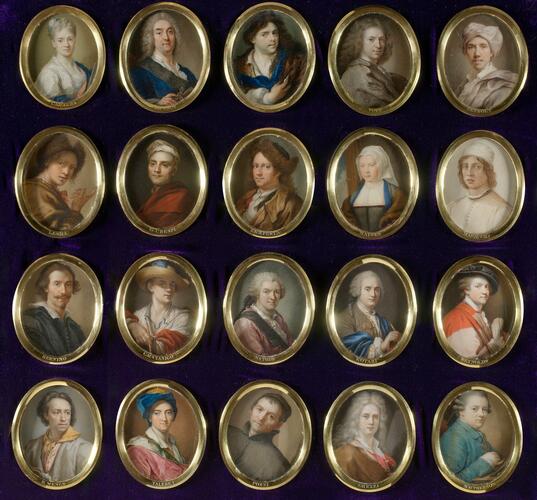Carel de Moor (1656-1738) c.1772-80
Watercolour on ivory | 7.0 x 5.4 cm (sight) (sight) | RCIN 421238
-
Carel de Moor (1656-1738) was a painter and engraver from Leiden. His father was an art dealer and maker of ebony frames who came originally from Antwerp. According to Arnold Houbraken, who knew de Moor personally, he studied first with Gerrit Dou in Leiden and then with the portraitist, Abraham van den Tempel, in Amsterdam. Afterwards, he returned to Leiden and became a pupil of Frans van Mieris the Elder, before completing his training with Godfried Schalcken in Dordrecht. In 1683, he became a member of the Leiden Guild of St Luke and served a number of times as deacon of the guild between 1688 and 1711. At the beginning of his career, he produced genre (scenes and subjects of ordinary life) and history paintings, but gradually portraiture took over as his principal activity. He enjoyed a great success as a portraitist and was internationally acclaimed: in 1714 he received a gold medal from the Holy Roman Emperor, Charles VI, in recognition of his talent. Around 1694, de Moor founded the Leidse Tekenacademie (Leiden Academy of Drawing) together with Willem van Mieris and Jacob van Toorenvliet and, with the former, was director until 1736. One of his paintings, The Duet (RCIN 406629), is in the Royal Collection.
This miniature is one of the collection of copies of 224 self-portraits by artists in the Uffizi Palace, Florence, that Lord Cowper, the art collector and patron, commissioned Giuseppe Macpherson (1726-1780) to paint. He presented the miniatures to King George III in two batches, in 1773 and 1786. Macpherson followed the original self-portraits quite closely, but copied only the head and shoulders. He inscribed the artists' names on the backs of the miniatures – several differ from those in the modern Uffizi catalogue, notably: Bazzi, Bellini, Campi, Annibale Carracci, Gabbiani, Masaccio, Metsys, Moroni, Pencz, Licinio, Schiavone and Spada. None of the miniatures is signed, apart from Macpherson's own self-portrait, which is inscribed: Giuseppe Macpherson / Autore della serie (Giuseppe Macpherson / Author of the series).Macpherson was born in Florence, the son of Donald Macpherson, a footman in the service of Alexander, 2nd Duke of Gordon. He was a pupil of Pompeo Batoni and painted miniatures and enamel portraits in Italy, France and Germany, finally settling in Florence. A James Macpherson is recorded in London and Paris in 1754 but it is not certain that this is the same person. He was described in 1776 as having a special talent for painting on enamel and as being 'almost the only painter in Europe who possesses this art to perfection'. He had a distinguished client list which included some of the crowned heads and dignitaries of Europe. In 1778, he was invited to add his own self-portrait to the famous painters in the grand duke's collection as it 'would do honour to Florence to enrich the collection with a work which shows that we still have some men of true merit' according to Giuseppe Pelli, director of the Uffizi at the time.Provenance
Presented to George III by Lord Cowper
-
Creator(s)
Acquirer(s)
-
Medium and techniques
Watercolour on ivory
Measurements
7.0 x 5.4 cm (sight) (sight)
Category
Object type(s)
Other number(s)
RL 01.8/3Alternative title(s)
Karel de Moor (1656-1738)










